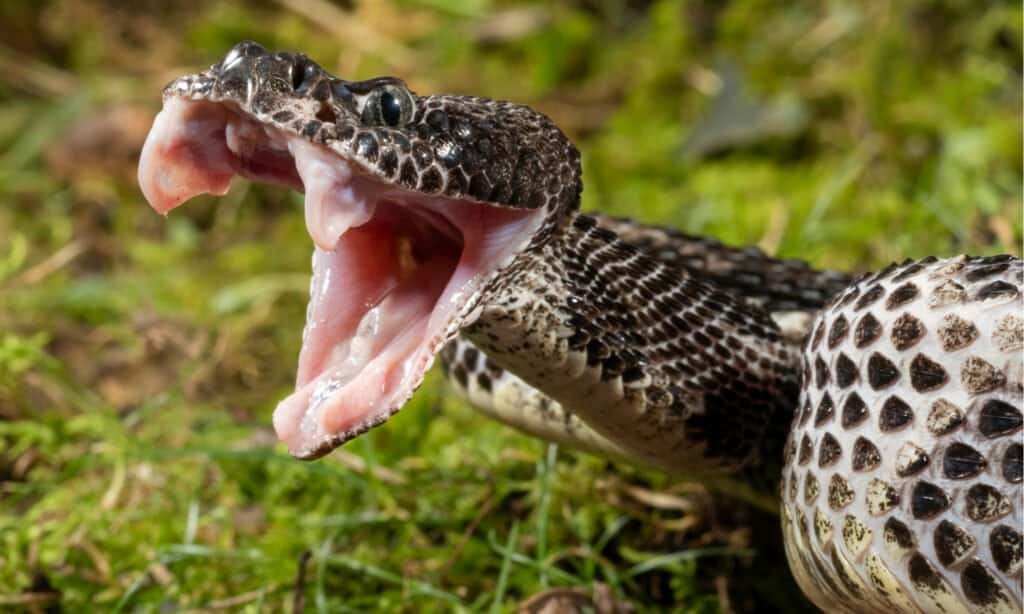Having a pet is a big responsibility, but sometimes, they can’t help but find themselves in a sticky situation. We all know that stomach-dropping feeling of seeing a dog running into danger to chase a squirrel. While motor vehicles are a serious concern for dogs, there is another sneaky threat that your dog could encounter in your yard—rattlesnakes! Today, we will be learning what to do if a rattlesnake bites your dog. Let’s get started.
How often do snakebites happen each year to pets?

Rattlesnakes are responsible for the most bites by venomous snakes each year.
©Joe McDonald/Shutterstock.com
The odds may seem unlikely, but if you live in the United States, the possibility of your dog running into a snake is always there. Each year, dogs and cats account for 150,000 of the 300,000 venomous snake bites reported on domestic animals. In fact, dogs, most likely due to their curious nature, are more than 20x more likely to be bitten by a venomous snake than a human.
In the United States, the most common type of venomous snake belongs to the pit viper family. The pit viper family includes the copperhead, cottonmouth, and all rattlesnake species. Together, pit vipers account for 99% of all venomous bites sustained by domestic animals.
Although it may seem scary to see all these stats, the good news is that you can take action to help your dog if it is bitten by a rattlesnake (or any snake). Let’s take a look at what you need to do.
What to do if a rattlesnake bites your dog

Identify the bite and seek medical attention immediately.
©Maria Dryfhout/Shutterstock.com
Most bites on dogs occur from April to October as snakes are more active and dogs are more likely to be exploring. The steps to take are given below.
Identify the bite
The first thing you need to do is identify the bite. If you actively saw your dog bitten by a snake, you can skip this part as you have all the information you need. Here are some symptoms of a dog affected by rattlesnake venom:
- localized swelling with two puncture wounds
- bleeding and sensitivity around a certain area
- limping, flinching, recoiling when touching certain areas
- salivation (abnormal levels)
- vomiting and diarrhea
- paralysis
- black and blue tissue damage (necrosis)
If you notice your dog displaying any of these symptoms and your dog was recently in an area with known populations of rattlesnakes, it’s possible it has been bitten. The most common place for a dog to be bitten is on its face or limbs, so those are the best places to check for bites.
Treating the bite
If the snake that has bitten your dog is a nonvenomous snake, the procedure is different. When you can confidently identify the snake as a nonvenomous species, washing the area with soap and water is the best course of action. Secondary infection is the only real danger in this case.
If you don’t know what kind of snake bit your dog, or you know that it was venomous, immediate medical treatment is necessary.
- carry your dog to your car as activity can spread the venom faster
- identify the snake (if you can do so safely) to aid the vet in administering treatment
- quickly drive your dog to the nearest vet or animal hospital
- Do not apply a tourniquet
- Try not to suck out the venom
- Do not apply hot or cold compresses
Once your dog has been admitted, the most likely course of action is flushing the area with saline and administering an antivenom (this is where your snake identification can come in handy). Once the antivenom has been administered, supportive care can be given (to aid in breathing and blood pressure), but waiting is all that is left to do.
Are dogs immune to rattlesnakes?

Dogs aren’t immune to snake venom, but larger breeds have more mass to dilute the venom through.
©Julia Shepeleva/Shutterstock.com
All domestic pets are susceptible to rattlesnake venom. Whether your dog or cat has been bitten, the best course of action is to immediately take them to the nearest vet for antivenin to be administered. The faster antivenin is administered, the higher the chance of survival.
Can a dog survive a rattlesnake bite?
Thankfully, dogs are hardy little creatures, and most of them survive snakebites, rattlesnakes included. In fact, 20% of the time that a rattlesnake bites a dog, it’s known as a “dry bite.” Snakes use dry bites as a warning to animals since they generally prefer to save their venom for their prey. Even if you think that a rattlesnake has given your pet a dry bite, medical care should still be sought as if your pet was envenomated.
The current statistics claim that dogs have a 5% mortality rate when bitten by rattlesnakes. This statistic doesn’t have any claims as to whether this is the untreated or overall mortality rate. Regardless, medical treatment is always imperative.
Keeping Your Pets from being bitten by Rattlesnakes

Reducing the food sources and hiding places for snakes in your yard can reduce the presence of snakes.
©MrDinger/Shutterstock.com
There are a few things you can do in order to reduce the risk of your dog being bitten by a snake.
Snakes are most active from April to October. You can ensure that your dog isn’t spending time running through thick brush where snakes generally prefer to hang out during these times. When taking your dog out during these times, please keep it on the trail and avoid common basking areas.
While walking in a snake habitat, rustling bushes and brush with a walking stick is a good way to warn any snakes that you are on your way through. Snakes don’t want to bite but will do so if surprised.
At home, do your best to reduce the food sources of venomous snakes. Reducing rodents such as cats and mice can reduce snake numbers. Additionally, leveling brush piles and woodpiles reduce places where snakes like to hide.
The photo featured at the top of this post is © Jeff W. Jarrett/Shutterstock.com
Thank you for reading! Have some feedback for us? Contact the AZ Animals editorial team.






